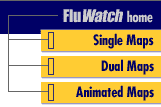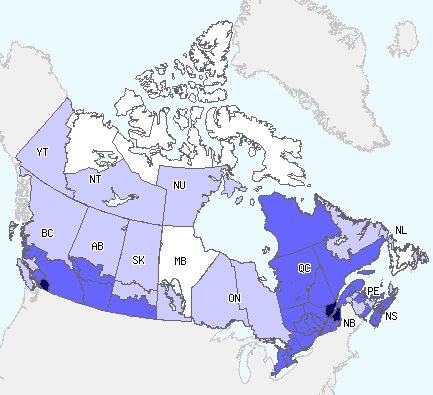Common menu bar links
E-mail this page
Fluwatch
Overall influenza activity increased from previous week
During week 14, overall influenza activity in Canada increased from the previous week with the majority of provinces having reported localized or widespread activity in at least one of their surveillance regions this week (with the exception of the Territories and NL). Widespread influenza activity was reported by 2 regions (in BC and QC) and localized influenza activity by 25 regions (the highest number reported this season to date). Six regions reported no activity and 20 reported sporadic activity (see map). Note: No data was received from the Toronto region in Ontario this week. In week 14, the percentage of specimens that tested positive for influenza increased slightly to 17.5% (827/4,726) for Canada as a whole; and regionally ranged from 82% in PEI to 5% in AB (see table). This week, the ILI consultation rate was 19 ILI consultations per 1,000 patient visits (see ILI graph), which is within the expected range for this week. The sentinel response rate was 60%. Fifty-one new outbreaks of influenza or ILI were reported this week as follows: 40 LTCFs, 1 hospital, 4 schools and 6 others.
Antigenic Characterization:
The National Microbiology Laboratory (NML) has characterized 1,022 influenza viruses for the 2007-2008 influenza season: 432 (42%) A(H1N1), 135 (13%) A(H3N2) and 455 (45%) B viruses. Of the 432 influenza A(H1N1) viruses characterized, 416 (96%) were antigenically similar to A/Solomon Islands/3/2006 and 16 (4%) were antigenically similar to A/Brisbane/59/2007. Of the 135 influenza A(H3N2) viruses characterized, 5 (4%) were antigenically similar to A/Wisconsin/67/2005 and 130 (96%) were antigenically similar to A/Brisbane/10/2007. One of the 5 A/Wisconsin-like viruses had reduced titer to A/Wisconsin/67/2005 reference antiserum. Of the 455 influenza B isolates characterized, 7 (2%) were antigenically similar to B/Malaysia/2506/2004 and 448 (98%) were antigenically similar to B/Florida/4/2006 (belonging to the B/Yamagata lineage) (see pie chart).
***The WHO recommends that the vaccines to be used in the 2008-2009 season (northern hemisphere) contain the following: an A/Brisbane/59/2007 (H1N1)-like virus; an A/Brisbane/10/2007 (H3N2)-like virus; and a B/Florida/4/2006-like virus.
Antiviral Resistance:
Since the start of the season, the NML has tested 762 influenza A isolates (500 H1N1 and 262 H3N2) for amantadine resistance and found that 260 (99%) of the 262 H3N2 isolates were resistant to amantadine and 5 (1%) of 500 H1N1 isolates were resistant (see recommendation from the 2006-2007 influenza season below).
The NML has also tested 943 influenza isolates (428 A/H1N1, 123 A/H3N2 & 392 B) for oseltamivir (Tamiflu) resistance and found that 87 (20.3%) of the 428 H1N1 isolates tested were resistant to oseltamivir. The resistant isolates were from NL, NS, NB, QC, ON, MB, AB and BC. These oseltamivir resistant strains remain sensitive to the antiviral amantadine.
Influenza-associated Paediatric Hospitalizations:
In week 14, there were 23 new laboratory-confirmed influenza-associated paediatric hospitalizations reported through the Immunization Monitoring Program Active (IMPACT) network from BC, AB, ON, QC and NS of which 14 (61%) were due to influenza A. Of the 386 hospitalizations reported so far this season, 63% (242/386) have been due to influenza A. The proportion of cases to date by age group are as follows: 21% were 0-5 month olds; 26% were 6-23 month olds; 23% were 2-4 year-olds; 20% were 5-9 year-olds; and 10% were 10-16 year-olds. Since the start of the season, 1 influenza-associated pediatric death has been reported to PHAC.
International:
WHO: During weeks 12–13, the level of overall influenza activity in the world decreased. Countries in northern Europe and the United States reported reduced activity. In Canada and the Russian Federation, activity remained mostly widespread. Hong Kong SAR China reported high activity.
CDC: During week 13, influenza activity and laboratory detections for influenza continued to decrease in the United States. Since September 30, 2007, CDC antigenically characterized 557 influenza viruses: 256 influenza A(H1) (175 A/Solomon Islands/3/2006-like, 19 showed somewhat reduced titers with antisera produced against A/Solomon Islands, and 62 were A/Brisbane/59/2007-like), 144 influenza A(H3) (34 A/Wisconsin/67/2005-like, 99 A/Brisbane/10/2007-like and 11 showed somewhat reduced titers with antisera produced against A/Wisconsin and A/Brisbane), and 157 influenza B viruses (8 belonging to the B/Victoria and 149 B/Yamagata lineage). Small numbers of influenza viruses resistant to oseltamivir have been detected in the United States, representing 6.5% (73/1,117) of all influenza viruses tested (9.2% among H1N1 viruses tested). To date, CDC has received a total of 59 reports of influenza-associated pediatric deaths that occurred this season.
EISS: Influenza activity in Europe for the 2007-2008 season is coming to an end with all countries reporting low levels of influenza activity this week. Virus detections of influenza are also declining for Europe as a whole. Whilst influenza activity was predominantly caused by the influenza A(H1N1) virus during most of the season, in recent weeks (since week 09/2008) influenza B has been dominant in Europe. Also for the few remaining influenza A cases, the balance has now changed such that A(H1) virus numbers have fallen to be just as rare as the A(H3) viruses which were the minority sub-type throughout the outbreak period. Influenza A(H1N1) viruses resistant to oseltamivir have been found in 19 countries in Europe with an overall prevalence of 23% (556/2362).
Human Avian Influenza: Since 5 April 2008, the WHO reported an additional fatal case of H5N1 avian influenza infection in a 19-year old male from Egypt.
Recommendation for the Use of Amantadine for Treatment and Prevention of Influenza
The Public Health Agency of Canada does not recommend the use of amantadine for treatment or prevention of influenza for the 2006-2007 season. This recommendation will be revisited if new information becomes available.
Total number of influenza tests performed and number of positive tests by province/territory of testing laboratory, Canada, 2007-2008
| Province
of reporting laboratories |
Report
Period: March 30 to April 5, 2008 |
Season
to Date: August 26, 2007 to April 5, 2008 |
||||||
| Total
# Influenza Tests |
# of Positive Tests | Total
# Influenza Tests |
# of Positive Tests | |||||
| Influenza A | Influenza B | Total | Influenza A | Influenza B | Total | |||
| NL | 94 | 7 | 4 | 11 | 1007 | 58 | 114 | 172 |
| PE | 11 | 1 | 8 | 9 | 116 | 2 | 16 | 18 |
| NS | 95 | 21 | 8 | 29 | 719 | 67 | 54 | 121 |
| NB | 108 | 5 | 31 | 36 | 946 | 89 | 118 | 207 |
| QC | 1564 | 137 | 113 | 250 | 23177 | 1907 | 657 | 2564 |
| ON | 1436 | 173 | 192 | 365 | 26404 | 1752 | 816 | 2568 |
| MB | 96 | 5 | 2 | 7 | 2427 | 78 | 30 | 108 |
| SK | 181 | 10 | 9 | 19 | 5123 | 317 | 267 | 584 |
| AB | 1016 | 33 | 21 | 54 | 25431 | 814 | 884 | 1698 |
| BC | 125 | 22 | 25 | 47 | 3135 | 518 | 431 | 949 |
| Canada | 4726 | 414 | 413 | 827 | 88485 | 5602 | 3387 | 8989 |
Specimens from NT, YT, and NU are sent to reference laboratories in other provinces.
Note: Cumulative data includes updates to previous weeks; due to reporting delays, the sum of weekly report totals do not add up to cumulative totals.
Abbreviations: Newfoundland/Labrador (NL), Prince Edward Island (PE), New Brunswick (NB), Nova Scotia (NS), Quebec (QC), Ontario (ON), Manitoba (MB), Saskatchewan (SK), Alberta (AB), British Columbia (BC), Yukon (YT), Northwest Territories (NT), Nunavut (NU)
Respiratory virus laboratory detections in Canada, by geographic
regions, are available weekly on the following website:
<http://www.phac-aspc.gc.ca/bid-bmi/dsd-dsm/rvdi-divr/index-eng.php>
Number of influenza surveillance regions† reporting widespread or localized influenza activity, Canada, by report week, 2007-2008 (N=54)

![]()
† sub-regions within the province or territory as defined by the provincial/territorial epidemiologist. Graph may change as late returns come in.
Influenza
Activity Level by Provincial and Territorial |
||||||||||||
|
||||||||||||
Note: Influenza activity levels, as represented on this map, are assigned and reported by Provincial and Territorial Ministries of Health, based on laboratory confirmations, sentinel ILI rates (see graphs and tables) and outbreaks. Please refer to detailed definitions. For areas where no data is reported, late reports from these provinces and territories will appear on the FluWatch website. Select single maps by report week to get this updated information.
<http://dsol-smed.phac-aspc.gc.ca/dsol-smed/fluwatch/fluwatch.phtml?lang=e>
Click on the map to view provinces/territories and maps for other weeks.
Influenza tests reported and percentage of tests positive, Canada, by report week, 2007-2008
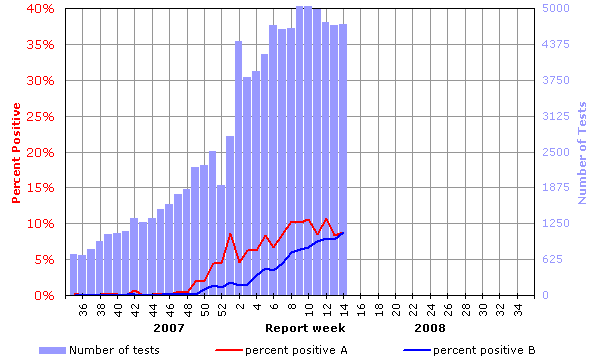
Percent positive influenza tests, compared to other respiratory viruses, Canada, by reporting week, 2007-2008
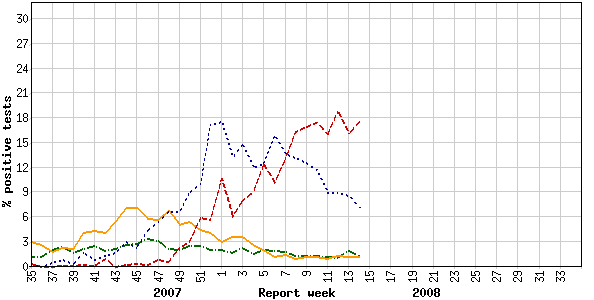
![]()
Influenza strain characterization, Canada, cumulative, 2007-2008 influenza season by the Respiratory Viruses Section at the National Microbiology Laboratory
[N=1,022]
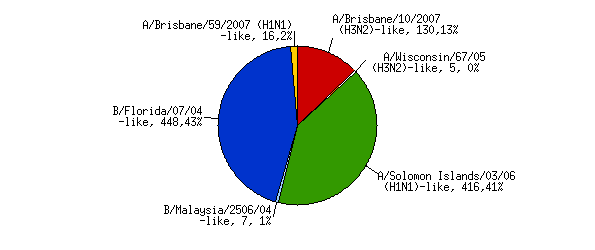
{Strain characterization, number identified, per cent of total number}
NACI recommends that the trivalent vaccine for the 2007-2008 season in Canada contain A/Solomon Islands/3/2006 (H1N1)-like virus; an A/Wisconsin/67/2005 (H3N2)-like virus; and a B/Malaysia/2506/2004-like virus.
Influenza-like illness (ILI) consultation rates, Canada, by report week, 2007-2008 compared to 1996/97 through to 2006/07 seasons
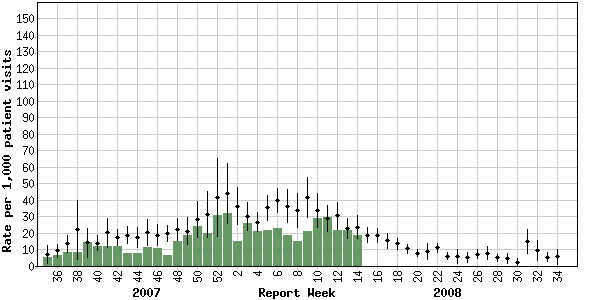
![]()
Note: No data available for mean rate in previous years for weeks 19 to 39 (1996-1997 through 2002-2003 seasons).
Number of New Outbreaks in Long Term Care Facilities, Canada, by Report Week, 2007-2008
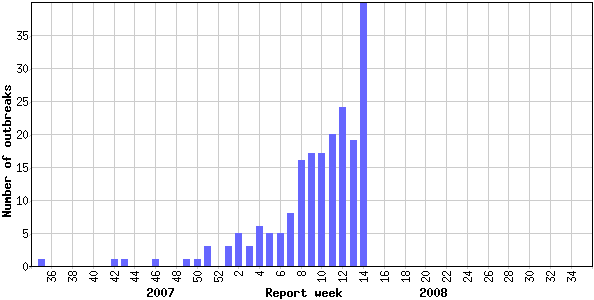
![]()
Please note that the above graphs may change as late returns come in.


